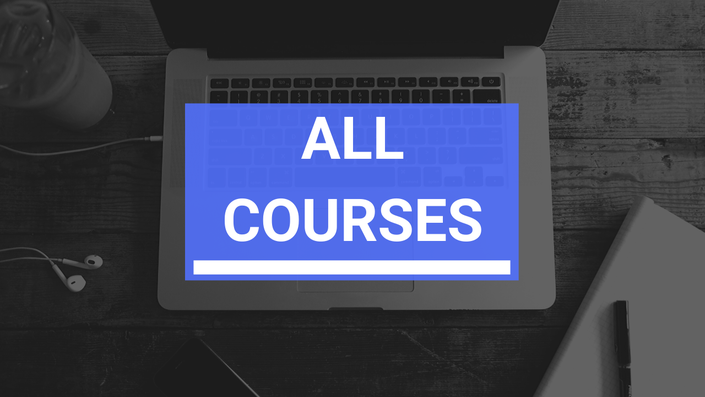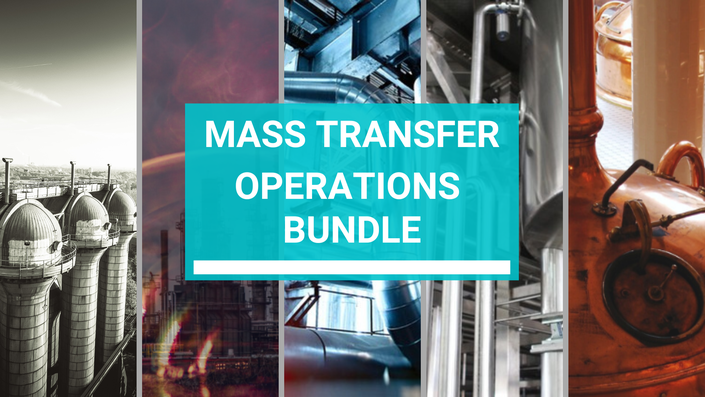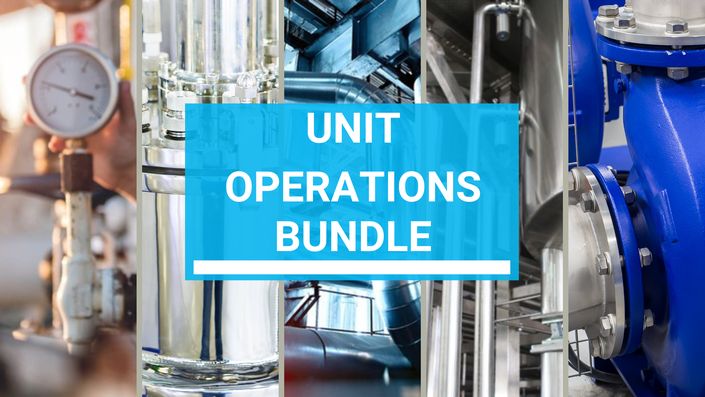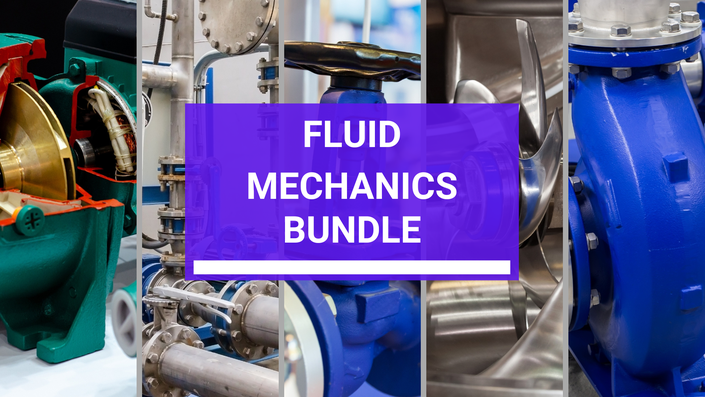Course Trailer
About this Course
📚 This Flash Distillation in Chemical & Process Engineering course dives into the fundamental principles and applications of flash distillation. You will learn how to efficiently separate components in a single-stage operation, optimizing process performance and energy use.
Key topics covered include:
- Flash Vaporization Principles
- Flash Distillation Equipment and Setup
- Thermodynamic Calculations (Vapor-Liquid Equilibrium)
- Effect of Pressure and Temperature on Separation
- Design of Flash Columns and Separators
- Energy Efficiency and Process Optimization
👨🏫 Designed for
Chemical engineering students, process engineers, and professionals interested in mastering flash distillation processes and improving separation efficiency in chemical plants.
📚 Course Approach
The course combines theoretical insights and practical examples, with case studies to help you understand real-world applications and design considerations.
🎯 By the end of the course, you will be able to:
- Understand the thermodynamics behind flash distillation and vapor-liquid equilibrium
- Design and size flash distillation units and separators
- Optimize the separation of components in a single-stage process
- Analyze key parameters like temperature, pressure, and composition for effective separations
- Improve energy efficiency and process performance in flash distillation operations
🚀 Recommended for
Students and engineers seeking to deepen their knowledge of separation processes, especially those involved in designing and optimizing distillation systems.
✅ You’ll learn to:
- Apply flash distillation calculations for single-stage separations
- Design and model flash distillation systems for various applications
- Optimize temperature, pressure, and feed conditions to maximize separation efficiency
- Use process simulation tools to model flash distillation units
- Implement energy-saving strategies in flash distillation processes

Self-Paced, Dynamic Lectures
Learn at your own pace, anytime and anywhere.
The lectures are concise, engaging, and focused—designed to maximize your understanding efficiently.

Downloadable Material
Get access to all simulation files, workshop materials, spreadsheets, reference guides and companion E-Book.
Use them to practice offline, follow along with lessons, or revisit concepts anytime.

Evaluations, Quizzes
Evaluate your progress through interactive quizzes and self-assessments.
Reinforce key concepts, identify gaps, and ensure you're ready to apply what you've learned in real scenarios.

30 Day Money-Back Warranty
Enroll with confidence—if the course doesn’t meet your expectations, you can request a full refund within 30 days.
No questions asked.

Certificate of Completion
Receive an official certificate or diploma once you finish the course—perfect for showcasing your new skills on your resume, LinkedIn, or job applications.

Instructor Support
Get guidance whenever you need it—ask questions, request feedback, and interact directly with the instructor throughout the course.
Curriculum
- Section 2 Introduction (2:53)
- Review - Mass Transfer (0:59)
- 2.1 Ideal Solution & Gas, Equilibrium, Vapor & Partial Pressures, VLE
- Ideal Gas Law (3:43)
- Ideal Solution (5:02)
- Vapor Pressure (5:29)
- Partial Pressure (3:44)
- Partial Pressure vs Vapor Pressure (3:42)
- Task – Partial & Vapor Pressure (0:38)
- What is Vapor Liquid Equilibrium for Pure substances (4:36)
- Vapor Liquid Equilibrium for Binary Systems (6:55)
- 2.2 Volatility (Chemistry)
- Volatility (Chemistry) (4:25)
- Task - Volatility of Substances (1:36)
- Relative Volatility (8:06)
- Special Case - Constant Relative Volatility (2:37)
- K-Values - An Overview (2:27)
- Task – Calculate a K-Value (4:01)
- 2.3 Phase Diagrams (Txy, Pxy, XY)
- Phase Rules & Diagrams (11:05)
- Task - Prove Phase Rule for VLE systems (2:18)
- Binary Diagrams (1:45)
- XY Diagrams (3:41)
- Task - XY Diagram (2:21)
- Bubble Point (3:03)
- Dew Point (2:38)
- T-XY Diagram (3:26)
- Analysis of T-XY Diagram (5:31)
- Task - Reading T-XY Diagram (0:41)
- P-XY Diagrams (5:16)
- Task - Reading P-XY Diagrams (2:22)
- 2.4 Ideal Solution – Ideal Gas: Raoult’s Law (Vapor-Liquid)
- Cases in Vapor-Liquid Equilibrium (2:43)
- Case 1 - Ideal solution and Ideal Gas (2:02)
- Raoult's Law (6:30)
- Ex - Raoults Law Application (9:09)
- Non-Ideal Solutions (4:49)
- Henry's Law (2:21)
- Ex - Henrys Law for Solubility (6:29)
- K-Values (revisited) (2:55)
- Case 2 - Real Soltion - Ideal Gas (3:33)
- Case 3 - Ideal Solution and Real Gas (2:36)
- Case 4 - Real Solution - Real Gases (3:17)
- Cases Conclusions - Ideal Gases and Solutions vs Real Gases and Solutions (1:58)
- 2.5 Deviations: Azeotropes
- Deviations of Ideality (4:49)
- Azeotropes (3:40)
- Miniumum boiling Azeotropes (4:04)
- Maximum Boiling Azeotrope (2:29)
- Task - Identify Azeotrope Types (1:26)
- Introduction to Azeotropic Distillation (2:20)
- 2.6 Getting VLE Data on Aspen Plus
- What is Aspen Plus (1:31)
- Getting VLE Data from Aspen Plus (2:41)
- Task - Graphing Txy Data with Binary Analysis Tools (6:05)
- Getting VLE Data from NIST Databases (3:13)
- Task - Extracting Binary Data using NIST Database (3:27)
- Section 2 Closure (1:32)
- Section 3 Introduction (3:15)
- 3.1 Process Technology Overview
- Flash Process Technology (6:53)
- Flash Diagrams & Drums (3:38)
- Task - Flash Drum Identification (0:54)
- Task – Recognize Horizontal Drum (1:03)
- 3.2 Flash Equipment
- Horizontal vs. Vertical Drums (4:00)
- Typical Dimensions of a Flash Drum (2:11)
- Hold-up Time for Flash Drums (2:29)
- Equipment & Other Auxiliaries (1:20)
- The Mesh aka Demister for Flash Drums Knockout (4:47)
- Drum Nozzles (3:20)
- Vortex Breakers (3:53)
- Foam Formation & breakers (1:39)
- Straightening Vanes (1:09)
- Baffles (2:33)
- Control System for Flash Drums (10:07)
- Task - Identify Control Systems in a Flash Drum (1:02)
- 3.3 Flash Operation & Design Calculations
- Sequential Method for Flash System (5:30)
- Operation Line in Separation Processes Technology (6:39)
- Variables of Interest for Flash Distillation (9:30)
- Operation Line of a Flash (FOL) (6:30)
- Analysis of the Flash Operation Line - Increase in Vapor Fraction in Feed (10:54)
- Animation - Flash Distillation of a Constant Relative Volatility Mixture (6:23)
- Worked Example - Flash Drum (9:45)
- Animation - Construct an x-y Diagram for Flash Distillation (4:25)
- Ex 1. Flash Distillation - 5 Cases of Vapor Fraction in Feed (11:44)
- Simulation of Ex 1 - Flash Cases Vapor Fraction from 0 to 100 (9:02)
- Ex 2. Partially Flashing an Alkane Mixture (5:34)
- Ex. 3 Flashing a Vapor Liquid Mix (8:30)
- Animation - Adiabatic Flash Drum with Binary Liquid Feed (7:07)
- Energy Balances on a Flash Drum (7:43)
- Animation T-x-y and x-y Diagrams for Binary Vapor-Liquid Equilibrium (VLE) in Flash Drum (6:02)
- Ex 1 - Flash Drum, Heatloads and Temperatures (12:26)
- Ex 2. Flashing System Using Enthalpies and Heat duties (10:28)
- Simulation of Ex 2 - Flashing Systems with Enthalpies and TXY Diagrams (8:56)
- Flash Drum Sizing (12:31)
- Ex 1 Flash Drum Sizing (10:43)
- Resources for Flash Drum Sizing (5:07)
- Task - Size the Flash Drum using External Resources for Ex 1 (1:22)
- 3.4 Flash Cascades
- Intuitive Approach for Flash Cascades (5:18)
- Flash Cascades - Analysis of Case 1 (5:34)
- Simulation 01 - Flash Cascades - Case Study 1 with no Recycle (14:32)
- Animation - Flash Distillation Cascade for an Acetone-Chloroform Mixture (3:53)
- Flash Cascades - Analysis of Case 2 - Recycling and Removal of Heat Exchangers (3:58)
- Simulation 02 - Flash Cascades - Case Study 2 with Recycle (V2) (5:13)
- Animation! Flash Distillation Cascade in a Constant Relative Volatility Mixture (3:38)
- Section 3 - Closure (1:02)
- Section 4 - Introduction (1:45)
- 4.1 Multicomponent Vapor Liquid Equilibrium
- Multicomponent VLE Introduction (3:44)
- Revisiting K-Values (Alkanes) (3:38)
- Animation! K-value of Several Hydrocarbons versus Temperature and Pressure (4:17)
- K-Value Charts of DePriester (7:13)
- Animation! K-value using DePriester Chart - Temperature and Pressure (3:55)
- Dew & Bubble Point Calculations in Multicomponent Systems (3:31)
- Bubble Point Calculations for Multicomponent System (4:28)
- Worked Example - Bubble Point Calculation for Multicimponent System using Reoults Law (3:57)
- Ex 1. Bubble Point Calculation using K-Values from DePriester Charts (8:30)
- Dew Point Calculation for Multicomponent Systems (5:02)
- Worked Example - Dew Point Calculation using Ideal Models (3:03)
- Task - Calculate the Dew Point of a Multicomponent System using K-Values and DePriester Chart (0:57)
- Simulation of Bubble & Dew Points of Several Hydrocarbon Mixtures (7:54)
- 4.2 Multicomponent Flash Distillation
- Derivation of Rachford-Rice Equation (10:18)
- Rachford-Rice Equation Procedure for Multicomponent Flashing (7:52)
- Worked Example - Rachford-Rice Equation for BTX (14:33)
- Ex 1. Rachford Rice Equation using K-Values from DePirester Chart (6:18)
- Ex 2. Rachford Rice Equation Values for high amount of Vapor (5:07)
- Animation! Flash Distillation of a Mixture of Four Hydrocarbons (2:47)
- Simulation of Ex 1 Multicomponent Flashing verifying Rachford Rice Equation Method (15:38)
- Section 4 - Closure (0:51)
Course Enrollment
This and all other courses are available only via the All Courses - One Subscription Membership.

Hi, I’m Emmanuel Ortega,
a.k.a. the Chemical Engineering Guy!
With five years in the chemical industry, from petrochemical plant design to polyester textiles, I bring real-world experience to show the true value of engineering knowledge.
My Expertise:
- Process Simulation & Optimization
- Chemical Process Design
- Process Equipment Design
- Automotive & Industrial Polyester Yarn Technologies
- Online Tutoring, Online Education Management
The Courses I design are entirely dynamic. You will see theory and then apply it ASAP to a real life problem! I even use the books you are using right now in your engineering courses...
I'll see you in class!
Frequently Asked Questions (FAQ)
- When does the course start and finish?
- The course starts now and never ends! It is a completely self-paced online course - you decide when you start and when you finish.
- How long do I have access to the course?
- *How does lifetime access sound? After enrolling, you have unlimited access to this course for as long as you like - across any and all devices you own.
- NOTE*: This is true as long as you keep your subscription active.
- What if I am unhappy with the course?
- We would never want you to be unhappy! If you are unsatisfied with your purchase, contact us in the first 30 days and we will give you a full refund.
- Will I Get a Certificate/Diploma of Completion?
- Yes! After the course, you will get a Certificate of Completion with a Diploma! You can use this in your Resume!
- Are Resources Downloadable?
- Absolutely YES! Every resource is available for download, allowing you to study alongside them.
- Any doubt? Message me!
- Please reach out! [email protected]




